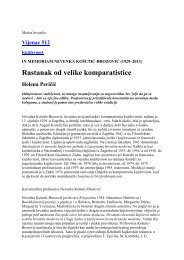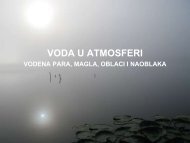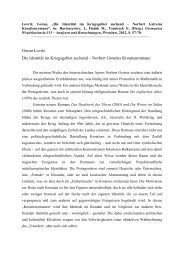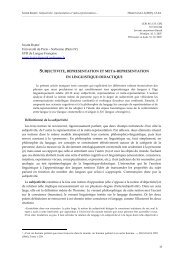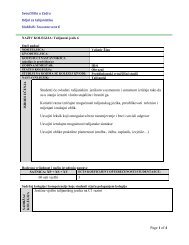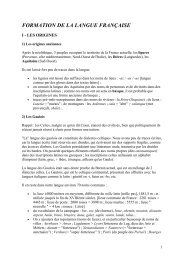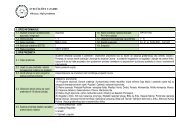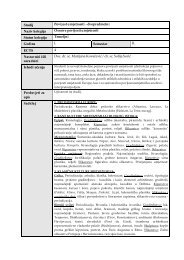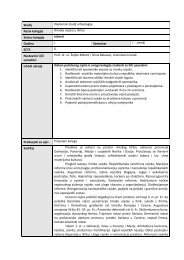TRANSITION FROM THE LATE HALLSTATT TO THE EARLY LA ...
TRANSITION FROM THE LATE HALLSTATT TO THE EARLY LA ...
TRANSITION FROM THE LATE HALLSTATT TO THE EARLY LA ...
You also want an ePaper? Increase the reach of your titles
YUMPU automatically turns print PDFs into web optimized ePapers that Google loves.
Session:<br />
<strong>TRANSITION</strong> <strong>FROM</strong> <strong>THE</strong> <strong><strong>LA</strong>TE</strong> <strong>HALLSTATT</strong> <strong>TO</strong> <strong>THE</strong> <strong>EARLY</strong><br />
<strong>LA</strong> TÈNE PERIOD<br />
Organizers:<br />
Discussant:<br />
Hrvoje Potrebica – Marko Dizdar<br />
Erzsebet Jerem<br />
The transitional period from the Late Hallstatt to the Early La Tène is not just<br />
a question of chronological distinction between the Early and the Late Iron Age. It is<br />
more cultural process that in different areas of Europe followed different patterns. We<br />
are especially interested in problem of initial exposure of the Late Hallstatt<br />
communities to the La Tène cultural influences and consequent mechanisms of<br />
cultural transfer that developed in different areas, which did not necessarily include<br />
influx of new population. The aim of this colloquium is to establish diversity of such<br />
patterns on examples of several case studies and offer fresh models for interpretation<br />
of this process which is crucial for understanding of later prehistory of Europe.<br />
LIST OF PARTICIPANTS<br />
NAME email COUNTRY<br />
Almássy Katalin & scholtzrobert@freemail.hu<br />
Hungary<br />
Scholtz Róbert<br />
scholtzrobert@gmail.com<br />
Arnold Bettina barnold@uwm.edu U.S.A.<br />
Bejinariu Ioan & bejinariuioan@yahoo.com<br />
Romania<br />
Pop Horea<br />
Collis John pr1jrc@sheffield.ac.uk UK<br />
Ignjatović Milorad dim.ignj@EUnet.yu Serbia<br />
Jerem Erzsebet elisabethjerem@hotmail.com Hungary<br />
Križ Borut borut.kriz@guest.arnes.si Slovenia<br />
Marton Erzsebet & martondr@freemail.hu<br />
Hungary<br />
Gati Csilla gatic@gmail.com<br />
Megaw Vincent vincent.megaw@flinders.edu.au Australia<br />
Potrebica Hrvoje & hrvoje.potrebica@zg.tcom.hr<br />
Croatia<br />
Dizdar Marko marko.dizdar@iarh.hr<br />
Ramsl Peter peter.ramsl@univie.ac.at Austria<br />
Rustoiu Aurel & aurelrustoiu@yahoo.com<br />
Romania<br />
Egri Mariana<br />
Sievers Sussane sievers@rgk.dainst.de Germany<br />
Stoellner Thomas Thomas.Stoellner@bergbaumuseum.de Germany<br />
Becker Katharina kbecker@mglarc.com Ireland<br />
Chytráček Miloslav chytracek@arup.cas.cz Czech
Culture or chronology: the transition from Hallstatt to La Tène.<br />
John Collis<br />
Over much of Europe the transition from Hallstatt to La Tène is linked with the<br />
‘arrival’ of the Celts. In this paper I wish to question the basic concepts that lie<br />
behind this. Is the idea of a ‘transition’ useful? Are concepts such as Hallstatt and La<br />
Tène ‘cultures’ useful? Are our models of a core area in which innovation took place,<br />
and expansion from it, actually supported by the archaeological data, or should we<br />
have more flexible models with multiple centres of innovation and diffusion similar to<br />
the linguistic ‘Wellen’ model (as opposed to the ‘Stammbaum’ model)? And what, if<br />
anything, does it have to do with the Celts? I suggest it is time for a complete rethink.
The lure of the Rhine maidens or where was the birthplace of early Celtic art?<br />
J.V.S. Megaw<br />
The paper considers what is currently thought to have contributed to the genesis of<br />
early Celtic art and how it may have developed during the transition from late<br />
Hallstatt to early La Tène. The claims of various regions southwestern Germany,<br />
the middle Rhineland, Bohemia, parts of Austria and northeastern France are also<br />
considered. While, as so frequently, no definitive answer can be supplied, it seems<br />
most logical to regard early Celtic art as a phenomenon which developed, not in one<br />
single zone, but in a number of different but interacting areas.
The „Fürstensitz“project: early urbanisation and centralisationprocesses<br />
Susanne Sievers<br />
The paper will inform about the “Fürstensitz”project, granted since 2004 by the DFG<br />
(German Research Foundation). The aim of the project is the research of early<br />
urbanisation and centralisationprocesses north of the Alps between the 7. and 4.<br />
century BC. About 7 areas in Central Europe will be studied and compared. The<br />
development of early celtic central places (“Fürstensitze”, princely sites) and the<br />
question, if those defended places are the earliest towns in Central Europe will be<br />
discussed. The paper will focus on some projects (for instance Heuneburg, Glauberg,<br />
Ipf ), their aims, methods and first results.
The Heuneburg Mortuary Landscape and the Hallstatt/La Tène Transition<br />
Bettina Arnold<br />
The Iron Age landscape associated with the Heuneburg hillfort on the Danube River<br />
in southwest Germany is one of the most extensively and intensively investigated site<br />
complexes in temperate Europe. The Iron Age occupation of the site is traditionally<br />
thought to have begun around 600 BC, with a destruction horizon marking the end of<br />
the mudbrick wall horizon ca. 540 BC. Significantly, the bulk of the Mediterranean<br />
imports found at the site date to the Hallstatt D2 occupation (Period III), which marks<br />
the postmudbrick wall settlement and also ends with a destruction horizon. The final<br />
Iron Age occupation at the site dates to La Tène A, and ends with a final destructive<br />
conflagration around 400 BC. The occupational history of the hillfort has been<br />
documented by a quarter century of excavations, recent survey work within a five<br />
kilometer radius of the hillfort has generated evidence of small supporting<br />
communities, and ongoing excavations in the associated outer settlement have<br />
yielded surprising new discoveries regarding the extent and nature of this sector of the<br />
site. The mortuary landscape has not been accorded as much attention apart from a<br />
period of intensive but largely unsystematic exploration in the 19 th century when<br />
several large mounds in close proximity to the hillfort were investigated. This was<br />
followed by a hiatus interrupted first by the partial excavation of the Hohmichele in<br />
the 1930s and then by the excavation of another of the large mounds near the hillfort<br />
in the 1950s, with reexcavation of mound remnants near the hillfort at intervals<br />
through 1989. Until recently, the received wisdom based on the rather limited data<br />
available was that the mounds associated with the Hohmichele, and the Hohmichele<br />
itself, represented the Hallstatt D3, mudbrick wall occupation, while the four large<br />
mounds near the hillfort (and presumably two other unexcavated large mounds<br />
downstream along the bluff edge) were assumed to postdate the mudbrick wall<br />
occupation, i.e. were later than 540 BC. It was not until 1999, when the “Landscape of<br />
Ancestors” project began investigations in two mounds near the Hohmichele, that any<br />
of the midsized burial monuments were systematically explored. The results of those<br />
excavations have not only rewritten the history of the mortuary landscape of the<br />
Heuneburg but can also contribute to the ongoing debate regarding the nature of the<br />
HallstattLa Tène transition in this region of southwest Germany.
From Hallstatt to the Latène in the Northern Alpine IronAge regions:<br />
Traditional and progressive regions in the light of new data<br />
Thomas Stöllner<br />
New dendrochronological data from the Dürrnberg draw a new picture on the<br />
transitional period: on the contrary to older arguments the transition of Hallstatt to<br />
Latène must be sought in the 2 nd quarter of the 5 th century BC. Such a chronological<br />
conclusion is supported by chronological arguments that can be deduced from Etrusan<br />
and Greek amphorae and ceramics found in the stratigraphy of Bagnolo San Vito but<br />
also on a discussion of the HeuneburgStratigraphy north of the Alps.<br />
It is fairly clear that the latest Hallstatt complexes of later Ha D3horizon must be<br />
dated around BC 480/470; there is on the other hand no doubt that the earliest<br />
complexes with Early Latèneornaments (e.g. platefibulas, belthooks, the earliest<br />
princely tombs) should be laid down not later than shortly after the mid of the 5 th<br />
century BC: The problem of the birth of Early Latène will be discussed on the basis of<br />
regional developments, on the basis of Early Latèneornaments and their connection<br />
to southern models as well as on a centre and peripherymodel. Early Latène has not<br />
developed rapidly without any internal development though it took less than a<br />
generation of its creation. Many cultural conditions found in the ripe and late phases<br />
of Early Latène have derived from this transitional period: The whole fifth century<br />
therefore is understood as a formation period of an Early Latène culture. It finally has<br />
included traditional Hallstattelements as well as the progressive transformation of<br />
southern pictures and ideology to creating a new style. It also concerns our<br />
understanding about Celtic as a cultural construct of the Iron Age.
Élite communities in Bohemia from the 6 th – 5 th century B.C. and longdistance<br />
relationships between the Mediterranean civilisations and Central Europe<br />
Miloslav Chytráček<br />
Whilst studying the development of the La Tènestyle in Bohemia we come to the<br />
conclusion, that its foundations were already established by the beginning of the Late<br />
Hallstatt period. Not suprisingly, Central Europe came into regular contact with the<br />
Mediterranean world in this time. Southern inspiration is clear e.g. in jewellery,<br />
pottery, horseharness, twowheeled chariots, sculpture and in architecture (for<br />
example in the construction of templepodia at the hillfort Závist in Bohemia).<br />
Imported Etruscan metal vessels became relatively common in Early La Tène<br />
contexts discovered in the western part of Bohemia. Attic drinking cups also found<br />
their way into Bohemian Basin, where they were further imitated. Numerous<br />
extraordinary items of Mediterranean origin distributed either in rich graves or at<br />
settlements clearly show that in the late 6 th and during the 5 th century B.C. several<br />
regions of Bohemia achieved important positions in the cultural and political<br />
development of Central Europe.<br />
These observations indicate concentration of power and property in specific regions,<br />
whose advantageous geographic setting and rich resources allowed local elite to<br />
maintain longdistance connections with advanced centres of Mediterranean world.<br />
Emergent preoppidum centres (in Bohemia especially the hillforts Závist and Vladař)<br />
were characterised by their extremely large fortification systems and integration into<br />
regional and supraregional transportation networks. The fortified area at the Vladař<br />
hill, located amidst rich gold resources, evidently became an important settlement<br />
agglomeration with distinctively elevated acropolis. The bronze pyxis foot dated from<br />
the 6 th /5 th century BC, which have been found at the acropolis, confirms that luxury<br />
goods coming from Northern Italy or Slovenia was present at the site.<br />
It is assumed that Czech lands did not grow in importance until the beginning of the<br />
6 th century B.C. when fortified residences along the old amber road running east of<br />
the Alps were destroyed; the amber being then transported in larger quantities via<br />
routes lying further to the west. Several indices point to the fact that it was during this<br />
particular period that the Bohemian Basin experienced its rise, which most probably
corresponded to considerable redirection of longdistance trade corridors in Central<br />
Europe.
Iron Age in Eastern Austria – an era and area of transition<br />
Peter C. Ramsl<br />
Eastern Austria – or better the northeastern part of Austria – is an interesting area,<br />
because of its function of transition.<br />
This paper deals with three important moments of the Iron Age in this area:<br />
1 – The late hallstatt/early latènen period with the settlement of<br />
Inzersdorf/Walpersdorf (Traisental) as a turntable from East to West<br />
It shows the distribution of early wheel turned pottery from West and East.<br />
2 The Early Latène Periods with the important cemeteries of Pottenbrunn<br />
(Traisental) and Mannersdorf (Leithagebirge) and the phenomena of central European<br />
mobility<br />
This point deals with costumes of female burials within the “Central European<br />
Corridor”. Here we recognise again some groups, which show interEuropean<br />
mobility.<br />
3 – The Late Latène Period with the settlement of Pellendorf (Weinviertel) and some<br />
ideas to the transition of the “celts” to “germanics”<br />
It asks if it is necessary to name tribes or ethnic groups or if we just see some<br />
moments of an economic and social transition.
Late Hallstatt/Early La Tene Transition in Eastern Slovenia (a case study of<br />
Novo Mesto)<br />
Borut Križ<br />
The Late Hallstatt/Early La Tene transition in Eastern Slovenia provide outlines of a<br />
very interesting model based on notions of continuity and cultural transformation<br />
which probably could also be applied to some other areas in Europe. Cemeteries in<br />
Novo Mesto (especially site at Kapiteljska Njiva) which have recently been subject of<br />
extensive research and systematic excavation give the best insight in specific features<br />
that make region of Lower Carniola (Dolenjska) one of the most important areas for<br />
study of Ha/Lt transition in this part of Europe. This paper will present those features<br />
and suggest basic explanatory models.
Pannons and Celts: New data to the history of the 5th4th centuries BC<br />
Erzsebet Jerem<br />
Recent major rescue excavations have yielded important finds from the transitional<br />
period of the Early and Late Iron Age. The analysis of these objects have considerably<br />
added to our knowledge of the period in question and have also put previous<br />
considerations into a new perspective. The rare, yet characteristic objects have been<br />
excavated from areas that were located far from the production centres or their usual<br />
areas of dispersion – this makes it possible to reconstruct the longdistance trade<br />
routes of ancient times. In the presentation I wish to give an account of the origins and<br />
dispersion of finds associated with Pannon female attire (beads, fibulae, belts and<br />
other jewellery, such as bracelets and anklets), and to highlight the close relationship<br />
that existed between the settlements in the area located between Transdanubia and the<br />
DrávaSzáva rivers during the Late Hallstatt and Early LT periods. I will aim to make<br />
a differentiation among the various relationships and their periods, and will also<br />
delineate a possible road network. Areas and sites of special topographical importance<br />
will also be placed under analysis.
Scythians and Celts along the Upper Tisza<br />
Katalin Almássy & Róbert Scholtz<br />
Nyíri Mezőség, the territory concerned in our lecture, is a micro region of the Upper<br />
Tisza and is located near an important ford of the Tisza river. The relationship of<br />
Scythian and Celtic populations once living in this territory has already been<br />
analysed. This analysis was mostly based one single „fortunate" site's material where<br />
the find ensembles contained objects from both populations. The analysis concluded<br />
that the cohabitation of Scythians and Celts only began in the middle of the IIIrd c.<br />
B.C. in this case. We now confront these results with the data obtained from three<br />
new rescue excavations made during the last years. Furthermore, our examination<br />
interrogates the historicalgeographical properties of the given territory in the Iron<br />
Age. Our analysis leads us to assume that our earlier claims are still valid: in some<br />
parts of the Great Hungarian Plain (Alföld) the Scythians resisted Celtic influences till<br />
the Middle La Tène Period. Since the material of the new excavations is currently<br />
under processing, our allegations remain hypothetic.
Late Hallstatt/Early La Tène in the Northern Croatia<br />
Hrvoje Potrebica – Marko Dizdar<br />
Mlađu fazu starijeg željeznog doba na prostoru sjeverne Hrvatske obilježile su<br />
različite kulturne pojave, većinom slabo poznate na osnovi rijetkih istraživanja naselja<br />
i pojedinačnih nalaza grobova. Oni zasad pokazuju kako je prostor sjeverozapadne<br />
Hrvatske na jugu povezan s Dolenjskom, dok se na sjeveru slijedi isti kulturološki<br />
model kao u susjednoj Štajerskoj i jugozapadnoj Transdanubiji. Od ranolatenskih<br />
nalaza poznati su samo nalazi fibula, većinom iz Siska, koje potječu iz<br />
kasnohalštatskog konteksta, a dospjele su razmjenom i trgovinom. U istočnom dijelu<br />
sjeverne Hrvatske kulturna slika u mlađoj fazi je drugačija i predstavlja sastavni dio<br />
južnopanonske skupine u kojoj se mogu prepoznati pojačani utjecaji s Balkana na<br />
jugu i donjeg Podunavlja na istoku, o čemu svjedoče nalazi iz ukopa konja u<br />
Vinkovcima. Ranolatenski nalazi poznati su većinom iz ženskih kosturnih grobova<br />
kao iz Velike, Osijeka, Dalja, Donje Doline, Bogdanovaca u kojima su pronađene<br />
brončane ranolatenske zoomorfne, Dux i Münsingen fibule, zajedno s<br />
kasnohalštatskim oblicima. One svjedoče o postojanju razmjene i trgovine, vjerojatno<br />
i egzogamiji, s prostorima na sjeveru Panonske nizine koji su već bili latenizirani. To<br />
je vrijeme prve polovice do početka druge polovice 4. st. pr. Kr. Posljednja<br />
istraživanja u Iloku na naselju bosutske grupe otkrila su objekte s ranolatenskim<br />
nalazima u dominantnom kasnohalštatskom kulturnom okružju, ali i nalaze koji<br />
ukazuju na utjecaje s juga. Broj ranolatenskih nalaza u znatnoj se mjeri povećava u<br />
drugoj polovici 4. st. pr. Kr., kada vjerojatno dolazi i do naseljavanja novog<br />
stanovništva koje je bilo nositelj latenske kulture. O tim događanjima svjedoče<br />
istraživana groblja na Karaburmi i Pećinama. Na taj se način prostor južne Panonije u<br />
4. st. pr. Kr. prikazuje kako područje intenzivnih kulturnih i ekonomskih kontakata iza<br />
kojih se kriju i određena migracijska kretanja na kraju kojih stoji početak mlađeg<br />
željeznog doba i nastanak Skordiska početkom 3. st. pr. Kr.
The Belgrade region in the Late Hallstatt period (Serbia, Danube Basin)<br />
Milorad Ignjatović<br />
This paper presents the results of the archaeological research on the Early Iron Age<br />
settlement of Karaburma near Belgrade (Danube Basin, Serbia). Ceramic material of<br />
the VI – IV Century B.C. is not chronologically indicative – vessels are simple in<br />
form and decoration is not characteristic. However, the discovery of a Certosa fibulae<br />
casting mold indicates that the settlement was occupied during the IV Century B.C.<br />
This dating enables us to draw a connection between this settlement and the earliest<br />
burials, with offerings of local manufacture, of the La Tène necropolis from the same<br />
locality.<br />
A number of later variants of the Certosa fibulae are already known from the vicinity<br />
of Belgrade, and their numbers south of the Sava and Danube rivers are increasing.<br />
Different variants of Thracian and Early La Tène fibulae also belong to this period.<br />
Put together, these finds show that the area under discussion, with its prominent<br />
geographic location, was at the time of the end of the Hallstatt period, going through a<br />
specific cultural development with a gradual influx of the Early La Tène style.
Transition from the Hallstatt period to the Early La Téne period in North<br />
Western Romania<br />
Ioan Bejinariu Horea Pop<br />
The aim of this paper is to present the most recent findings belonging to final Hallstatt<br />
period from northwestern Romania. The most important finds come from<br />
excavations of two new archaeological station belonging to Hallstatt D period from<br />
western part of Sălaj county. Until now, in northwestern Romania, this period is<br />
known, especial by funeral discoveries (cremation graves in urns) from Carei Plain.<br />
Only few discoveries come from settlements.<br />
Both settlements in approach are located in an important passing place from Barcău<br />
river valley, between the Upper Tisza region and Transsylvania.<br />
Between 20022003 the settlement from Porţ „Corău” have been investigated. Two<br />
dwellings and several pits have been excavated. The majority of ceramics is represent<br />
by handmade pottery but an exception is a fragment of wheelmade pottery from L1<br />
dweeling. We can remark perpetuation of some pottery type of Gava tradition, like<br />
bowls with introvert rim, fragments of doublecolour pots (black outside, brick<br />
colored inside), but new types like tronconical jug with high bail. The ceramics<br />
indicated analogies with Vekerzug culture discoveries from Tisza Plain. Socalled<br />
„easterntype” or „scitian type” artefacts are represented by small bronze arrowheads<br />
with three edges. The place have been short time inhabited by a small group of<br />
inhabitants during the 2 –nd half of VI century B.C.<br />
The settlement from Porţ „Paliş” is located not to far from the first one (no more than<br />
3 km) and have been investigated in 2003 and 20062007 as a part of rescue<br />
excavations from „Transylvania Motorway” project. Until now (april 2007) 130<br />
features have been excavated (defensive system, dwellings, pits and cremation graves)<br />
and it is the single fortifyed settlement from Late Hallstatt period in northwestern<br />
Romania. The site from Porţ „Paliş” have been inhabited between the 2 nd half of V<br />
century and the 1 st half of IV century B.C. The wheelmade pottery have been<br />
discoveried in a large amount comparatively with the settlement from „Corău”.<br />
Missing the artefats by eastern type.
The Early La Tène and the impact of Celtic colonisation in Transylvania<br />
Aurel Rustoiu Mariana Egri<br />
The problem of transition from the First to the Second Iron Age in Transylvania<br />
(inner Carpathian area of Romania) is connected with the “expansion” of Celtic<br />
communities to the east. This fact can be demonstrated through the analysis of the<br />
ethnic and cultural situation from the region at the end of the First Iron Age. During<br />
this period was observed the presence of some clearly individualised cultures and<br />
cultural groups (Szentes – Vekerzug in the Western Plain, local cultural groups in<br />
Central Transylvania, Banat and Maramures). All of them experienced a series of<br />
influences and inputs from the ThracianIllyrian space (in Banat and Transylvania), or<br />
from the northern Pontic regions (in the western and northern area). However, the<br />
elements which are specific to the La Tene cultural circle are absent.<br />
Together with the beginning of the Celtic colonisation (at the end of LT B1 and<br />
beginning of LT B2), the general aspect of the material culture was radically<br />
modified. The newcomers imposed their own “models” and structures, but they had<br />
also cohabited with the local communities. The existence of a strong local stratum<br />
determined the apparition of a La Tene culture mixed with local elements during the<br />
Second Iron Age. This is one of the essential characteristics of the Celtic world from<br />
the eastern Carpathian Basin.<br />
However, the Celts had not occupied whole Transylvania and in the isolated<br />
depressions from the east and west the local communities of the First Iron Age<br />
continued their evolution. These were not “contaminated” with elements belonging to<br />
the La Tene culture. Their social structures were similar to those from the regions to<br />
the east of the Carpathians, as the recent archaeological researches in the Maramures,<br />
on Upper Tisa have shown.
The Late Bronze Age – La Tène transition in Ireland<br />
Katharina Becker<br />
After the occurrence of a few individual Hallstatt C artefacts in the record, it is only<br />
with the appearance of La Tène style artefacts that an Iron Age becomes recognisable<br />
in the Irish archaeological record. Recent excavation results indicate that at least in<br />
terms of settlement forms Late Bronze Age traditions continued, despite the fact that<br />
iron working technology had been adapted centuries earlier. This paper will<br />
specifically focus on the selective deposition of artefacts and discuss what it implies<br />
regarding the reception and selection processes at work in the introduction of the Iron<br />
Age to Ireland.
Late Hallstatt/Early La Tène transition at the site of Szajk (with special concern<br />
to spinning and weaving tradition in the Iron Age)<br />
Erzsébet Marton Csilla Gati<br />
The first part of paper will discuss some specific features related the Late<br />
Hallstatt/Early La Tène transition at the site of Szajk, while the second part will<br />
discuss significance of spinning and weaving in the Iron Age, from the Hallstatt<br />
period to the last centuries A.D., using evidence from the site of Szajk, as well as<br />
from other less known Iron Age sites.




